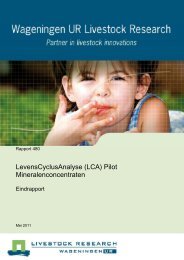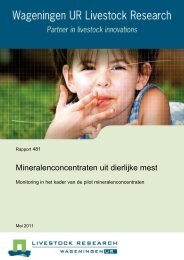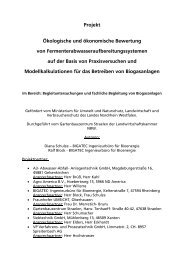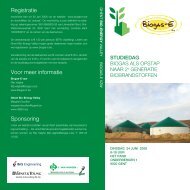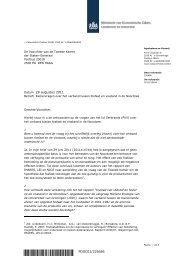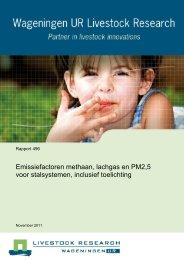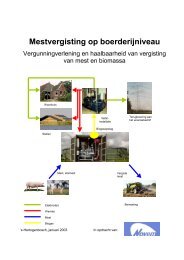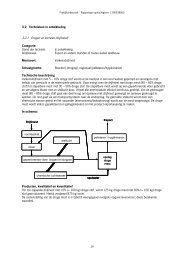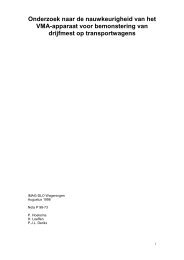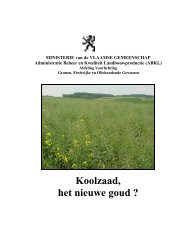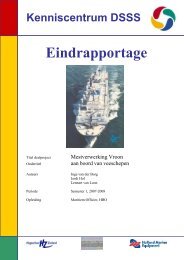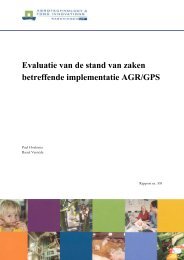Monitoring methane and nitrous oxide reduction by manure treatment
Monitoring methane and nitrous oxide reduction by manure treatment
Monitoring methane and nitrous oxide reduction by manure treatment
Create successful ePaper yourself
Turn your PDF publications into a flip-book with our unique Google optimized e-Paper software.
Report 627<br />
The amount of solid, liquid <strong>and</strong> meadow <strong>manure</strong> per animal (of a specific sub-category) per year is<br />
determined <strong>by</strong> the WUM (working group for uniform calculation of <strong>manure</strong> <strong>and</strong> mineral figures). The<br />
<strong>manure</strong> production factors are updated every year if necessary. They are publiced on www.cbs.nl.<br />
The fraction of volatile solids in the <strong>manure</strong> (VS) varies per animal category depending on feed<br />
composition. Dutch values are documented in Van der Hoek & Van Schijndel (2006). The maximum<br />
<strong>methane</strong> formation (B0) depends on degradability of organic components in the <strong>manure</strong>. B0 values per<br />
animal category are fixed <strong>and</strong> taken from Zeeman (1994) <strong>and</strong> Zeeman & Gerbens (2002).<br />
The <strong>methane</strong> conversion factor (MCF) indicates the extent to which the degradable substances will<br />
actually be converted into <strong>methane</strong>. The IPCC provides a default value of MCF = 0 for liquid <strong>manure</strong><br />
stored less than one month, <strong>and</strong> MCF = 0.39 for liquid <strong>manure</strong> stored longer than one month. The<br />
Netherl<strong>and</strong>s uses a country specific MCF documented in the NIR (Van der Maas et al., 2009)<br />
Activity data<br />
Animal population<br />
Animal numbers per category are monitored in the annual Agricultural Census. They are publiced on<br />
www.cbs.nl.<br />
Amounts of <strong>manure</strong> per management system<br />
The method of calculating amounts of <strong>manure</strong> differentiates between liquid <strong>manure</strong> produced in the<br />
stable period, solid <strong>manure</strong> produced in the stable period <strong>and</strong> <strong>manure</strong> produced in the meadow. Data<br />
on the amounts of <strong>manure</strong> per management system are determined <strong>by</strong> the WUM. They are publiced<br />
on www.cbs.nl.<br />
2.2 N2O from <strong>manure</strong> management<br />
The protocol refers to N2O emissions from <strong>manure</strong> produced in animal houses, <strong>and</strong> then stored <strong>and</strong>/or<br />
processed before being transported elsewhere.<br />
N2O emissions from animal <strong>manure</strong> management depend on the nitrogen <strong>and</strong> carbon content of the<br />
<strong>manure</strong>, the amount of time the <strong>manure</strong> is stored <strong>and</strong> the <strong>treatment</strong> method used. During storage the<br />
<strong>manure</strong> usualy becomes low-oxygen, which slows the nitrification <strong>and</strong> denitrification process.<br />
+<br />
Nitrification is the process where<strong>by</strong>, under high-oxygen circumstances, ammonia (NH4 ) is converted<br />
-<br />
into nitrate (NO3 ). N2O can be formed as a <strong>by</strong>-product, particularly if the oxygen concentration is low.<br />
Nitrification does not require any organic substances (volatile solids) to be present. Denitrification is<br />
the process where<strong>by</strong>, under low-oxygen circumstances, bacteria can convert nitrate into the gaseous<br />
nitrogen compound N2, with N2O as a <strong>by</strong>-product. N2O emissions from solid <strong>manure</strong> are higher than<br />
from liquid <strong>manure</strong>, because there is very little nitrification in the latter due to the lack of oxygen.<br />
Calculation method<br />
N2O emissions from animal <strong>manure</strong> are calculated as follows:<br />
N2O emissions = ∑[ EFij ] * 44/28<br />
ij<br />
* [ amount of N in <strong>manure</strong> per animal in animal category (i)<br />
<strong>and</strong> <strong>manure</strong> management system (j) ]<br />
* [ number of animals per animal category (i) <strong>and</strong> <strong>manure</strong><br />
management system(j) ]<br />
N2O emissions : N2O emissions from <strong>manure</strong> management, in kg<br />
EFij<br />
: emission factor for the defined animal category <strong>and</strong> <strong>manure</strong> management system (i) in kg N2O-<br />
N/kg N excreted <strong>manure</strong><br />
44/28 : conversion factor from kg N2O-N to kg N2O<br />
Two <strong>manure</strong> management systems are distinguished: system for liquid <strong>manure</strong> <strong>and</strong> system for solid<br />
<strong>manure</strong>.<br />
3





